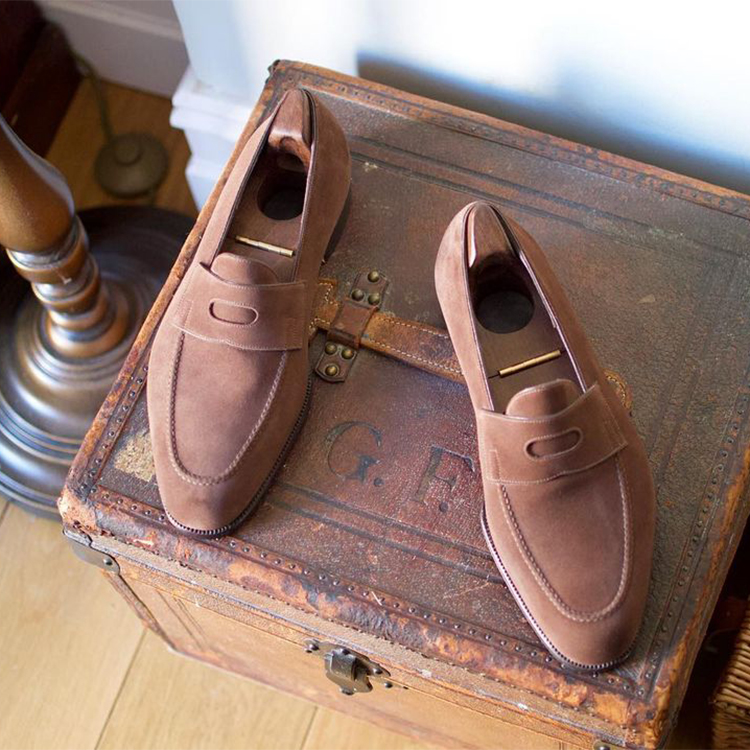
If I could only have three pairs of shoes, I’d go with a pair of loafers, some Norwegian split-toes, and some kind of boot (either work boots or side-zips). Like most men, I rarely wear a “serious suit” nowadays. “Serious suits” are limited to weddings, funerals, and other “serious occasions,” which means I don’t have much use for formal shoes such as oxfords (which, to my eye, only look right with suits). Derbies, on the other hand, can be worn with suits or sport coats, which gives them some versatility.
Loafers are more casual still. For most people, they can be worn three seasons out of the year. They go just as well with summer sport coats as they do with autumnal tweeds. Depending on their design, they can also be worn with casual outfits. Loafers are easy to slip off and easier to slip on. And if you’re the type of person to wear shoes without socks, bare ankles look more natural with slip-ons than lace-ups.
Choosing the right pair, however, requires some sensitivity to different design elements. Some loafers look better with sharply tailored trousers, while others look more at home with faded jeans. Some lean traditional, while others are fashion-forward. There’s no such thing as an “ultimate loafer,” but there are some that are better suited to your needs, lifestyle, and wardrobe. Here are some choices, along with suggestions on how to think through these various design elements.
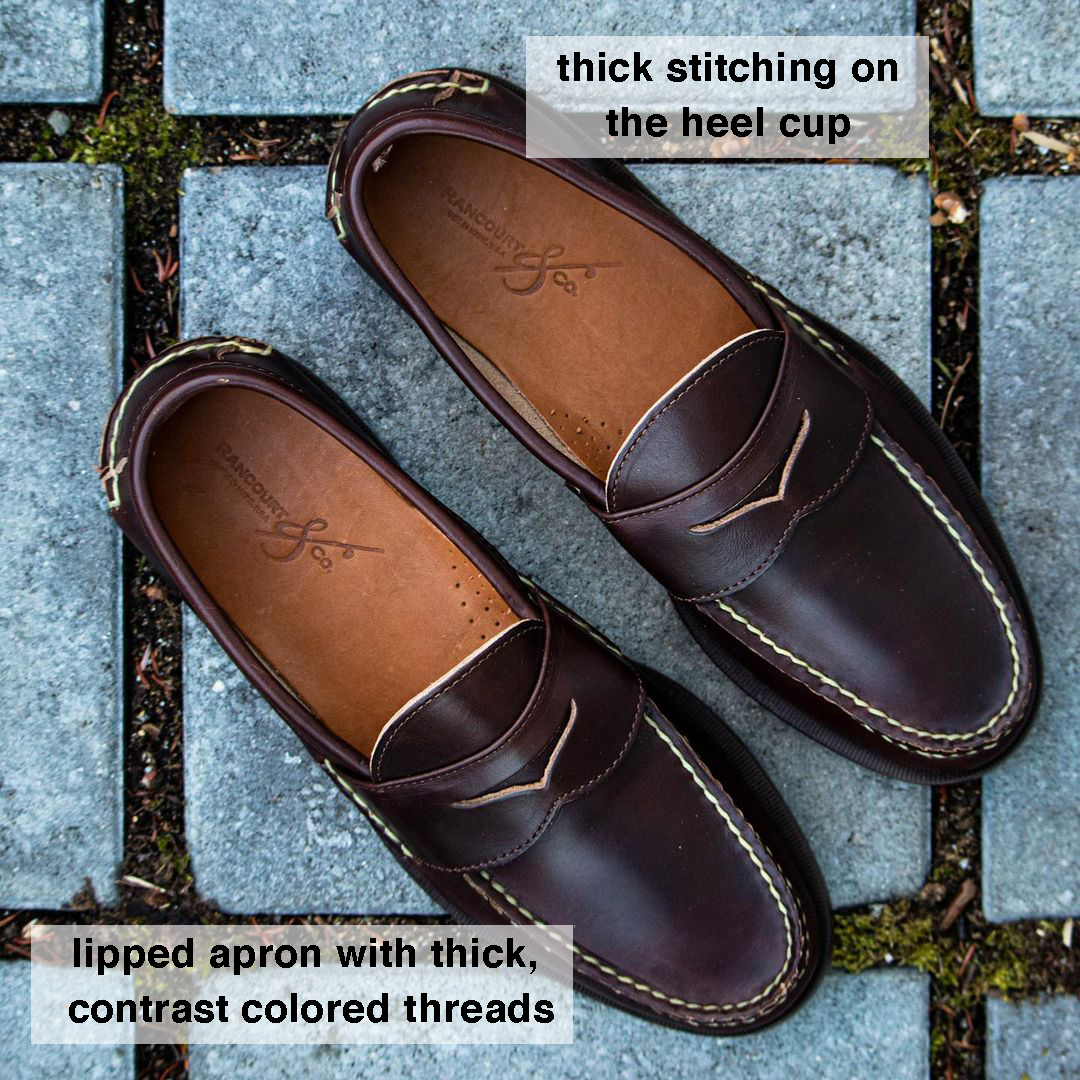
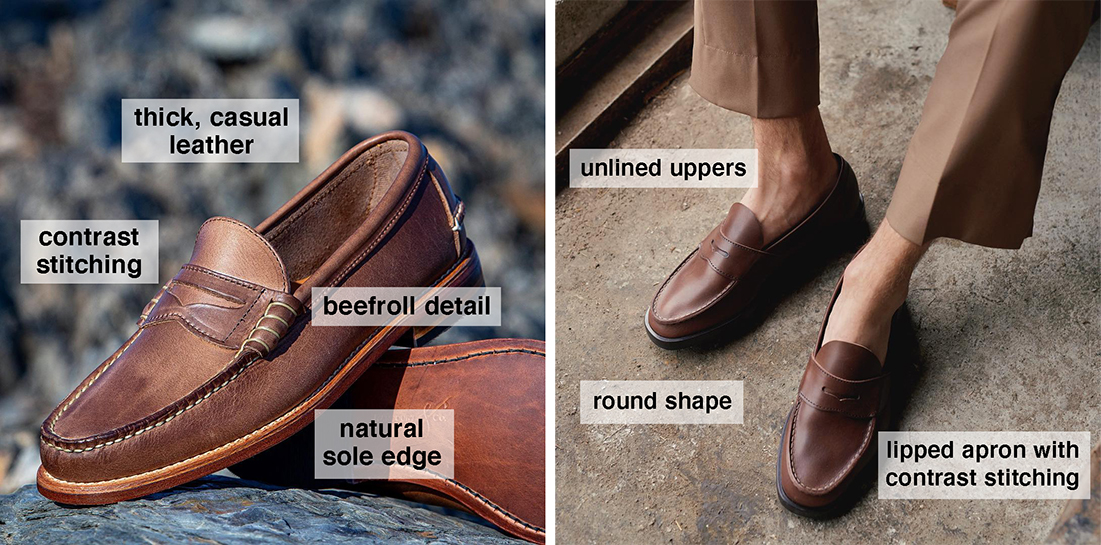
The Casual Penny Loafer
When you close your eyes and imagine a penny loafer, you’re probably thinking of something like Bass Weejuns. These are your most casual pennies. Depending on their design, you can wear them with tailored chinos and a safari jacket or something as simple as jeans and a Harrington. You can even wear them with shorts and a madras shirt (a very New England look).
When trying to discern a loafer’s formality, look first at the shape. Casual loafers will be rounder than their sleeker, more formal counterparts. They will often have minimal shaping near the waist (that part of the shoe that comes in near the arch of your foot).
There may be other casualizing elements. Some penny loafers are made from a more casual leather, such as Horween’s Chromexcel. Others may be unlined, which means the uppers feel more comfortable, but they’ll reveal the shape of your foot more readily when worn (sort of like espadrilles). Many will have rougher stitching — a lower stitch count per inch, contrast colored threads, thicker threads, and saddle stitching around the apron (that part of the shoe that sits at the edge of the toe box). An apron with a raised lipped will look more casual than one that’s flatter and more discrete. Beefrolls on both sides of the penny strap, a stitched ridge at the heel cup, and flat rubber sole can also make a loafer look casual.
You can find these from brands such as Rancourt, Oak Street Bootmakers, and Jay Butler. Slightly more refined versions, such as Aurland (supposedly the original penny loafer), will have a similar casual vibe, but look less trad. These are the type of loafers you’ll want to wear with jeans, chinos, or shorts when hanging out at a BBQ, relaxing in the neighborhood, or doing other casual activities. Keep them with casualwear, rather than tailoring.
Options: Sid Mashburn, Ralph Lauren, Oak Street Bootmakers, Rancourt, Aurland, Shipton & Heneage Milan, and Jay Butler Cromwell
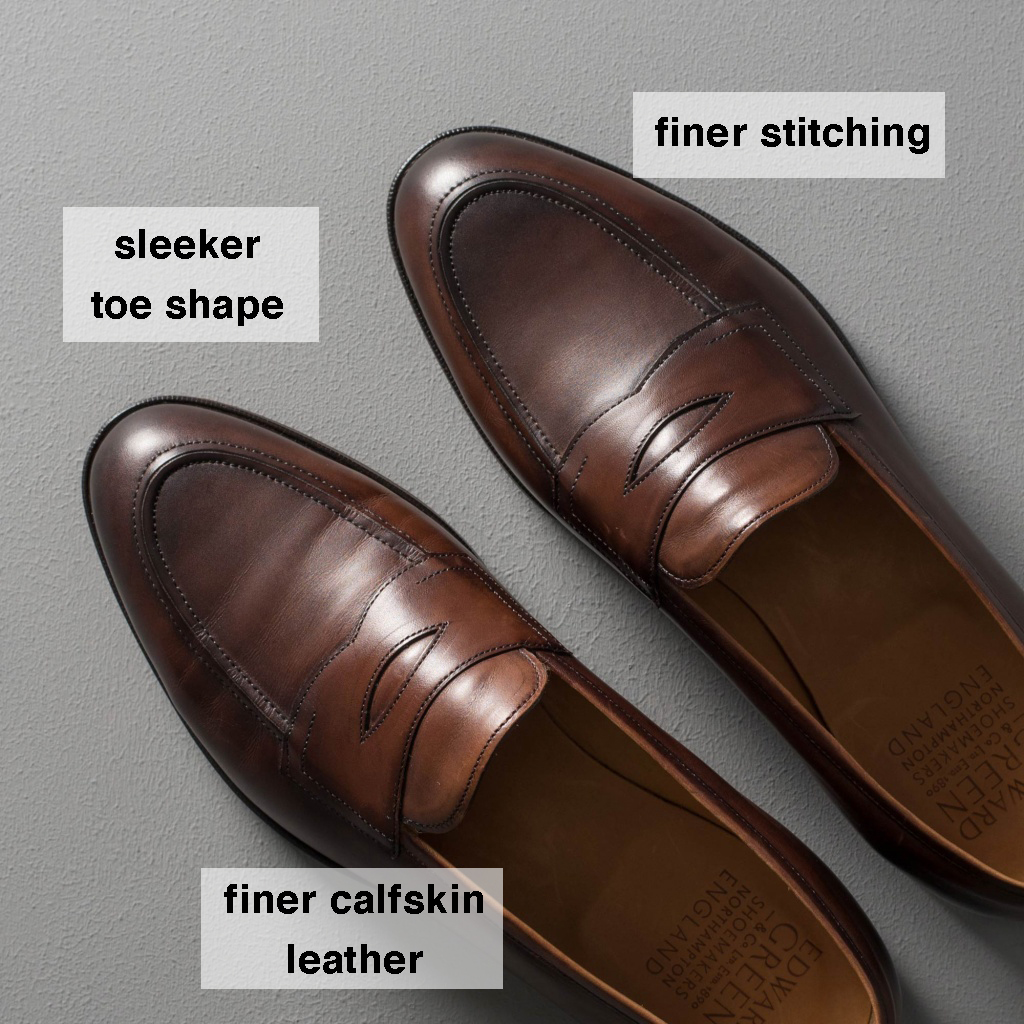
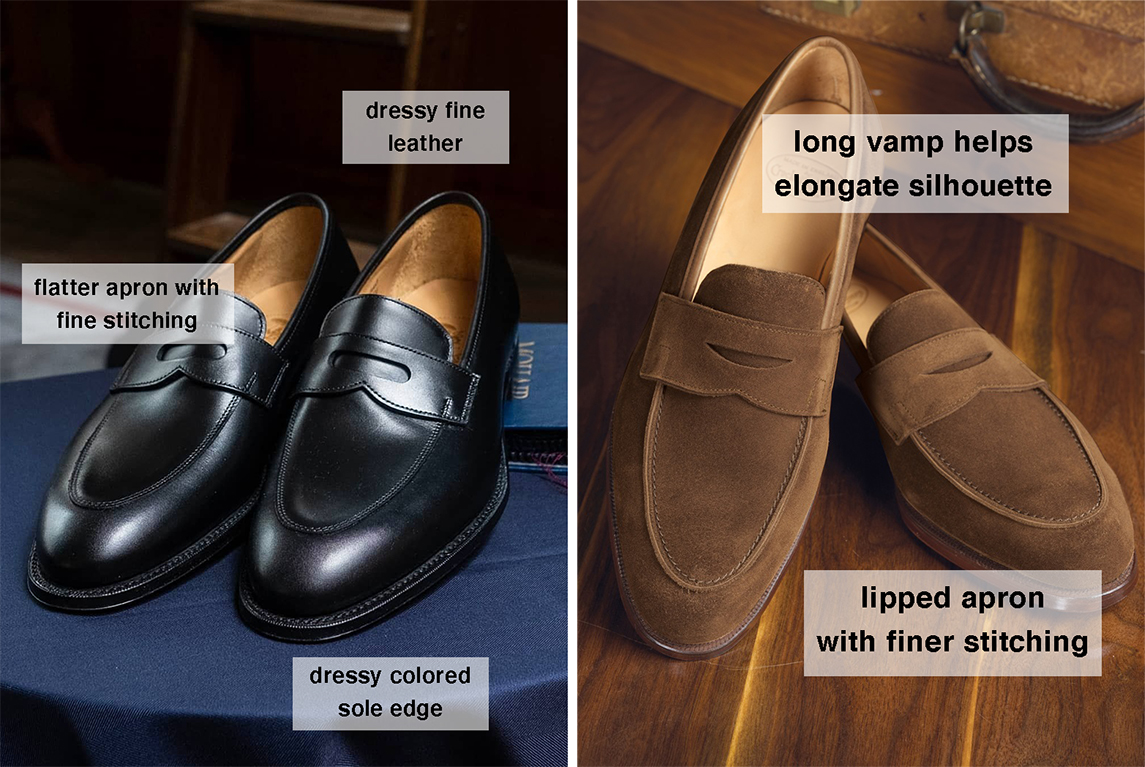
The Dressy Penny Loafer
If you want something you can wear with suits and sport coats, choose a sleeker, more shapely penny loafer made from fine calfskin or suede. Loafers with finer, tonal stitching look dressier than ones with rougher stitching. A flatter apron will often look dressier than one with a raised lip, but it’s all about execution. In the photo above, you can see a pair of Crockett & Jones Rosebery with a subtly raised lip that still looks relatively formal. It’s just not as raised or rough as what you see on these Ralph Laurens.
The design of the vamp here is often overlooked as a design element. The term vamp refers to that part of the shoe that sits on top of your foot. High-vamp loafers come up higher on your foot, while low-vamp loafers terminate closer to your toes. As Mark Cho of The Armoury demonstrates in the video above, even when loafers are built on the same last, a higher vamp can help elongate the shape of your foot. This makes the shoes look sleeker and thus dressier.
For me, Edward Green’s Piccadilly is the Platonic form of a dressy loafer. It’s sleek and shapely without being aggressively sharp. When made with the company’s dark oak leather, it’s something you can wear with nearly any tailored outfit. The only problem is the price. At about $1,300 retail, it’s painfully expensive. Even on eBay, you’ll find gently used versions going for about $750. Solid alternatives include Foster & Son Burford, The Armoury’s Duane, Carmina 80191, Sons of Henrey, and Meermin 114284.
Options: Edward Green Piccadilly, The Armoury Duane, George Cleverley Bradley, Crockett & Jones Rosebery, Löf & Tung Francisco, Löf & Tung Abreau, Morjas, Carmina 80708, Carmina 80191, Alden, TLB Mallorca Martin, TLB Mallorca Artista, Sons of Henrey, Shipton & Heneage Wilton, Meermin 114284, and Meermin 101484
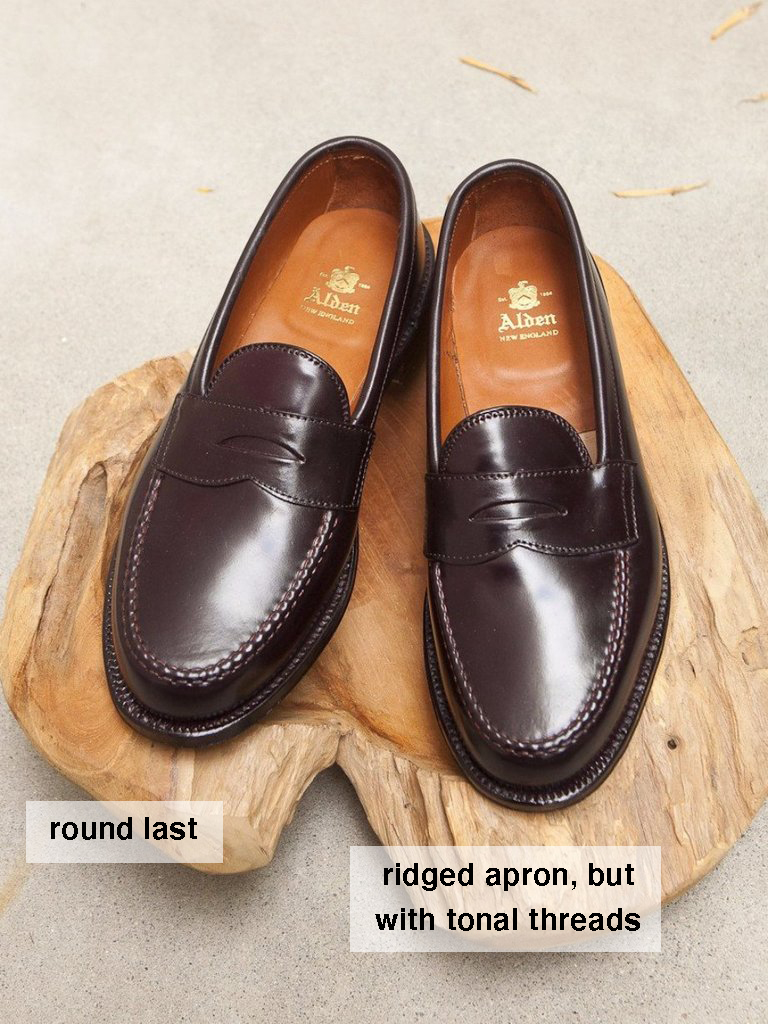
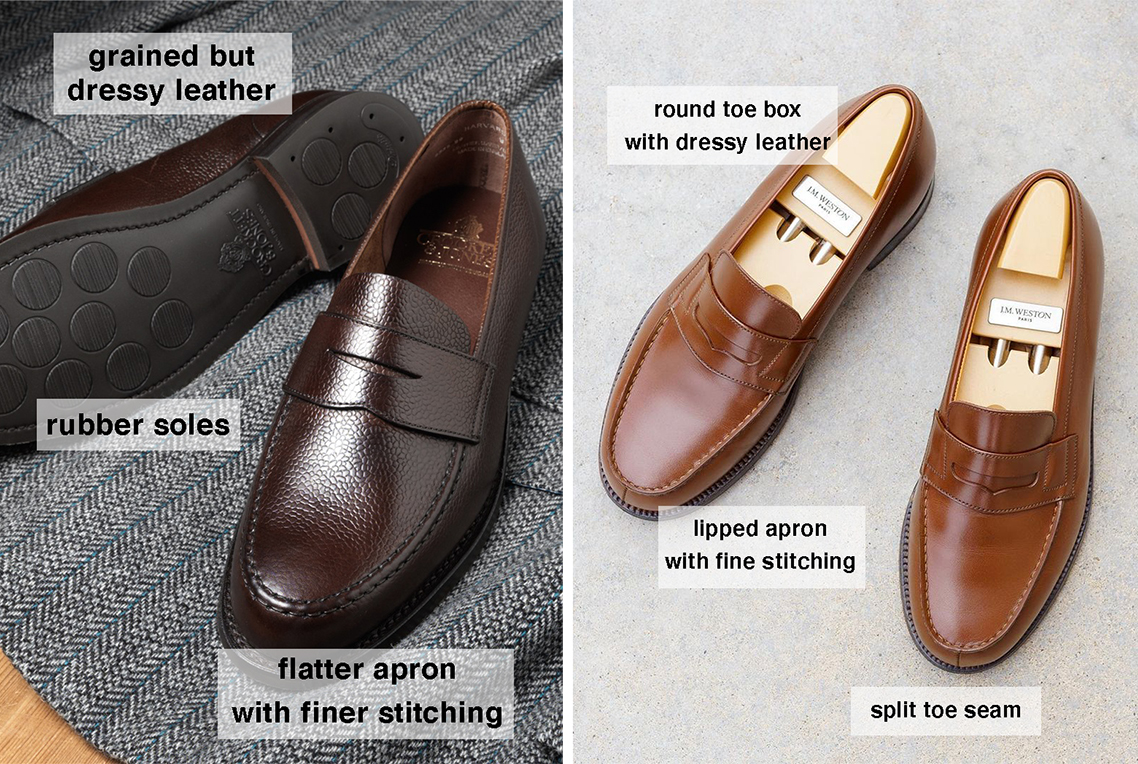
The In-Betweener Penny Loafer
Dressy loafers look most at home with tailored clothing, while casual loafers look better when kept to casualwear. But what if you want a versatile loafer that can do both? Straddling these two worlds can be like threading a needle, but it can be done.
First, a lot depends on your wardrobe. If your tailoring leans trad (more straight-waisted American, rather sleek Italian or structured British) and your casualwear leans classic, it’s easier to find loafers that can do double duty. The key is to get loafers with a mix of the different design elements mentioned above: a rounder last, rather than sleek, and something with a combination of formal and informal elements. You want something made from a “dress shoe” leather, such as fine calfskin, scotch grain leather, or shell cordovan, rather than uber-casual material such as Horween’s Chromexcel. Raised lipped aprons and split-toe seams can make a dressy loafer look causal, but beefrolls would be a step too far.
There are two excellent options here. Alden’s Leisure Handsewn (colloquially known as the LHS) is ideal if your style leans trad. It’s perfect for wearing with things such as Shetland sweaters, oxford button-downs, and five-pocket cords. At the same time, you can dress it up with a sport coat and pair of flannel trousers. This is the post-war Ivy look — a style that perfectly expresses the dressed-down, tailored style that the United States made famous. Get the LHS in Horween’s #8 shell cordovan if you can afford it. Otherwise, it also looks great in brown suede.
Alternatively, you can also try JM Weston’s 180, a high-walled penny loafer that’s closely associated with the BCBG social group in France. In the United States, this JM Weston loafer doesn’t carry the same class connotations, so it’s easier to wear these with a mix of things. The 180 goes well with tailored trousers and a sport coat, sometimes even casual suits. At the same time, the chunky silhouette looks natural with jeans and casualwear from labels such as Camoshita, Private White VC, and De Bonne Facture.
Options: Alden Leisure Handsewn, JM Weston 180, Crockett & Jones Boston, Crockett & Jones Harvard, Löf & Tung Xavier, John Lobb Lopez, Sid Mashburn, Carmina 80579, Carmina 10082, Allen Edmonds Randolph, Allen Edmonds Cavanaugh, Grant Stone Traveler, Barbanera, Shipton & Heneage Arran, and Vass Norweger

The Flashy Horsebit Loafer
In the world of slip-on shoes, no style is more controversial than the horsebit. The style is associated with flashy dressers, aggressive powerbrokers, and arrivistes. In the 2013 film The Wolf of Wall Street, New York stockbroker Jordan Belfort (played by Leonard DiCaprio) wears jet-black Gucci horsebit loafers with strong-shouldered pinstripe suits, starched white collars, and power ties. The silhouette perfectly conveys the sort of greed-is-good ethos that we associate with bankers in the 1980s, when this film was set.
Reasonably, many people shy away from snaffle bit loafers for these reasons. They can feel too aggressive and flashy, like wearing the footwear version of a gold Rolex. At the same time, the style has some important design elements that make it surprisingly versatile. The ridged apron and rounded toe allow it to look at home with jeans, while the dressy leather and shiny horsebit make dressy enough for suits. In his book Elegance, Bruce Boyer writes: “In short, it was the first shoe that bridged the gap between casual and business wear. This dressy slip-on was refined with fine, lightweight calfskin, a pared-down shape, and a metal snaffle bit, and as such, it became avenue-elegant and gained acceptance in corporate board rooms and country clubs alike.”
If you’re anything like me, you’ll probably never step foot in a country club or corporate board room. But there’s still something appealing about this loafer. It looks great with drapey suits or sport coats — ones cut with a broader shoulder line, longer coat, and pleated trousers — or even casualwear from brands such as Aime Leon Dore (this is a very Gucci horsebit outfit).
Since it’s the original, the Gucci 1953 is naturally the most iconic. It’s the shoe that has been in the costume collection of New York’s Metropolitan Museum, Lisa Birnbach’s 1980 tongue-in-cheek guide The Official Preppy Handbook, and countless films and TV shows. But there are also many worthwhile alternatives, including Carmina’s 580746 and Alden’s Cape Cod. Jay Butler’s Milbank is perhaps the most affordable of all. If you’re buying something because you want a cheaper version of the Gucci, then you will end up being disappointed because it’ll live in the shadow of the thing you want. But I think many of these other shoes are good on their own merits. Carmina’s are lined in calfskin, rather than Gucci’s use of canvas, while Alden’s have a made-in-USA cred that will be important in trad circles. Buy the one that appeals most to you.
Options: Gucci 1953, Carmina 580746, Carmina 80570, Jay Butler Milbank, Allen Edmonds Verona II, Beckett Simonon Beaumont, Oak Street Bootmakers, and Alden Cape Cod
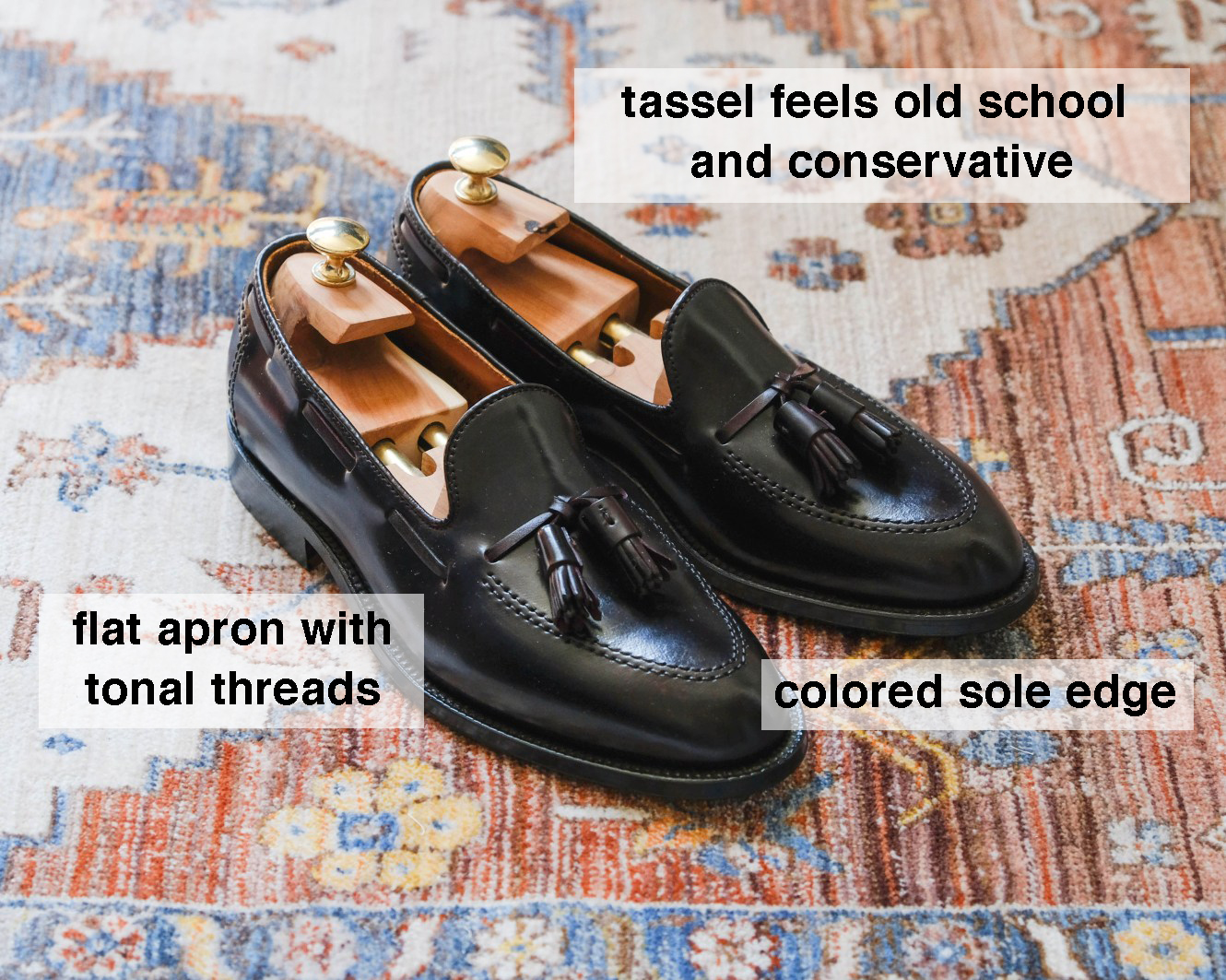
The Conservative Tassel Loafer
A few years ago, I was hanging out with my friend Agyesh Madan, the owner and designer behind the Italian-inspired casualwear line Stoffa. That day, Agyesh wore a grey suede flight jacket, taupe cotton trousers, and a pair of blue suede Belgian loafers. Belgians aren’t an easy style to pull off. They’re a little dainty and ostentatious, with a ridiculous, miniature bow sitting on the vamp. You usually see them on white, upper-class preps hanging around the Hamptons (or, more likely, guys who like to affect the same pretenses). Agyesh can pull them off because he’s anything but. As an Indian man with a scruffy beard, who wears leather jackets as part of his daily uniform, Agyesh says Belgians help soften his look.
Which is how I feel about the question that gets asked every summer: “Are tassel loafers only for old guys?” The answer is yes, which is why anyone can wear them. Whether you’re 30 or 60 years old, into traditional American style or something more contemporary, tassel loafers can work so long as you know how to incorporate them into your wardrobe. It’s all about playing into or against the social stereotype.
I fell in love with tassel loafers in much the same way that I fell in love with a lot of classic clothing: I got inspired by how other cultures adopted these items. I love how older Japanese guys in the tailoring industry wear tassel loafers, particularly those inspired by Italian men who copy British and American dressers. In this remixing of culture, you often see jaunty tassel loafers worn with soft-shouldered suits and sport coats, trad-y outfits involving Shetland sweaters, and even a bit of workwear.
For me, nothing beats Alden. Along with being the originator of this style, their tassel loafers have that perfect low-vamp shape and rounded toe box. This is the sort of shoe you see shuffling around dusty trad shops such as O’Connell’s. But there are also some other good contenders, such as the tassel loafers from Sid Mashburn, The Armoury, and Ralph Lauren. Brown will always be your most versatile color, but black tassel loafers are surprising chic and useful. You can wear them in any outfit where you can imagine wearing a black knit tie. They go with navy sport coats and grey trousers, brown tweeds paired with taupe whipcords, and any kind of suit.
Options: Alden, Ralph Lauren Booth, Ralph Lauren Quillis, Allen Edmonds Grayson, Sid Mashburn, Carmina 80481, Edward Green Belgravia, The Armoury Hudson, Foster & Son Arlington, Morjas, Oak Street Bootmakers, TLB Mallorca Lancaster, Grant Stone, Barbanera, Shipton & Heneage Finchley, Meermin 101412, and Meermin 101381
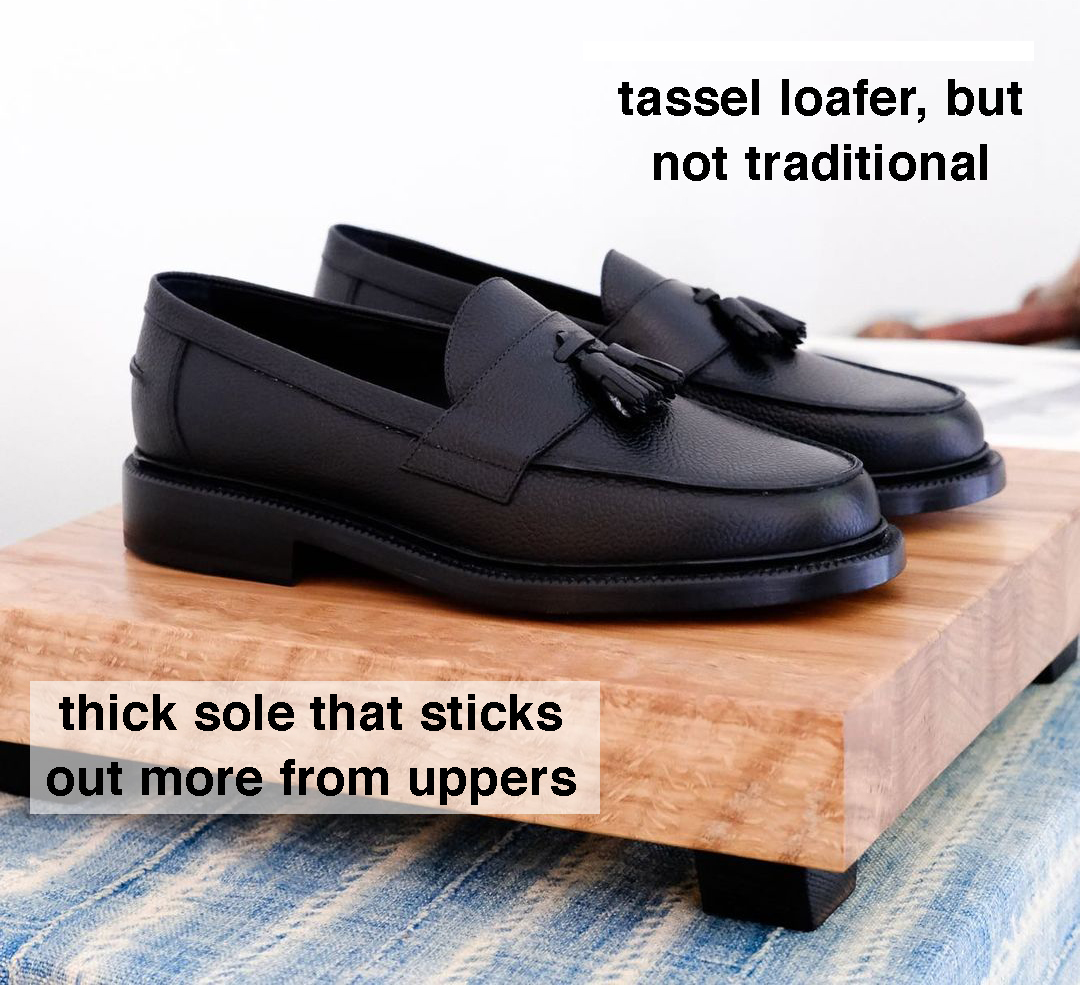
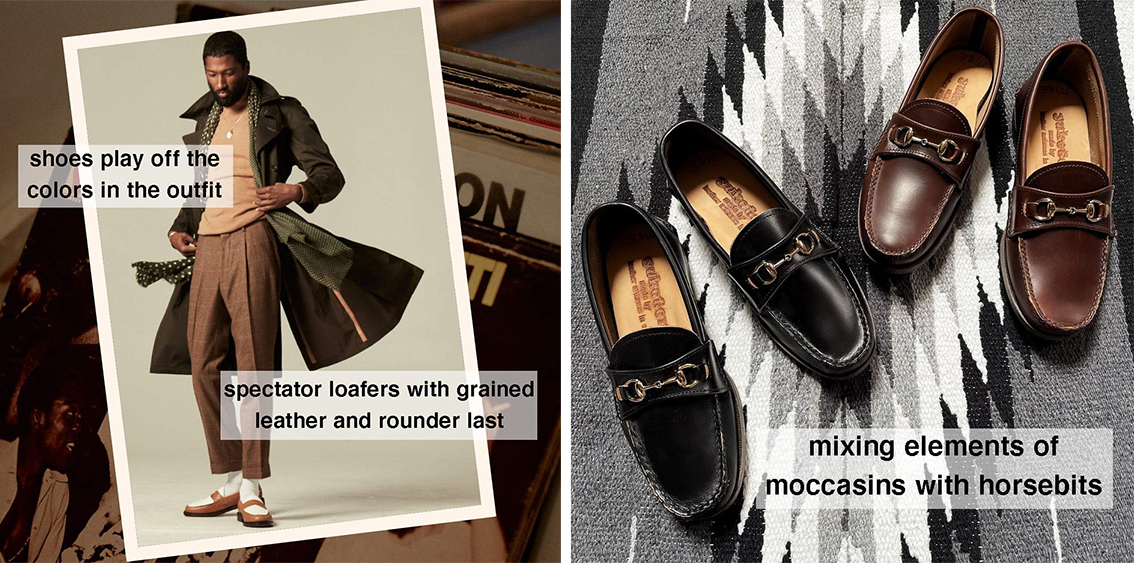
The “Post Sneaker” Loafer
For a small community of men online, there has been a lot of chatter lately about whether we’re entering a “post sneaker world.” This prophetic phrase, fueled by Lawrence Schlossman and James’ Harris podcast Throwing Fits, suggests that some men are tired of entering and losing raffles for rare Nikes and subsequently paying inflated prices on the secondary market. They may also be looking to dress more appropriately for their age. As many move from shopping at Supreme to Aime Leon Dore, they’re searching for shoes to match.
Earlier this month, Jacob Gallagher of the Wall Street Journal wrote about this section of “very tapped-in twenty- or thirtysomething consumers.” “[T]he Throwing Fits listeners and their cohort are not interested in tasteful yet generic Allen Edmonds, or the sort of safely somber Salvatore Ferragamo dress loafers you might have worn for decades. They’re more intrigued by designs from upstart, mostly online-only brands that tweak loafers with aplomb.”
It’s difficult to describe the “post sneaker loafer,” but as Gallagher notes, these are not your traditional styles. These companies mix elements from various designs, such as the chunky, 360-degree welt you might find on a country brogue with an unusually designed tassel loafer. Or a camp moc with a snaffle bit on the strap. Fundamentally, these are designed to be worn with slightly more fashion-forward outfits, such as the workwear style you might find at Monitaly or Engineered Garments.
You can see how these outfits are put together in Blackstock & Weber’s lookbook. The taupe, windowpane trousers, tan sweater, and long olive trenchcoat in the photo above is a reasonably classic outfit, but in a more modern color combination. It also looks great with the subtly updated Blackstock & Weber spectator loafers, which have a chunkier silhouette than traditional varieties. Crockett & Jones’ Crewe loafer looks too refined in comparison. I like Blackstock & Weber’s Mason horsebit loafer the most. Available pebble grain or embossed croc, it’s something you can wear with slim jeans and fuzzy mohair cardigans, camp collar shirts, or open lace tops. “They’re great if you like chunky shoes,” says No Man Walks Alone’s Greg Lellouche, who owns a pair in brown suede and with lug soles. “I think of them more as a Timberland 3-eye lug than a menswear loafer.”
Options: Blackstock & Weber, Aime Leon Dore, Horatio, Vinny’s, and Yuketen







